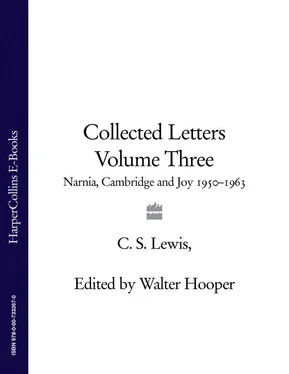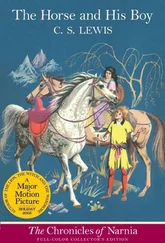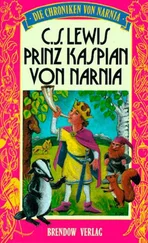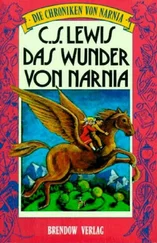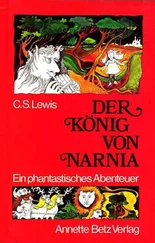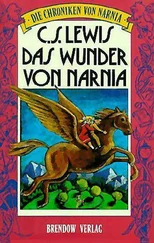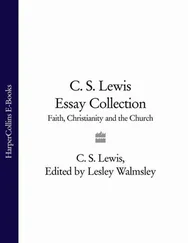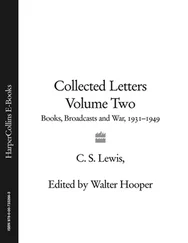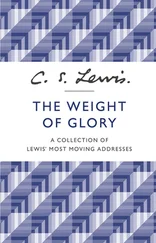Turning to the second theme of these letters–Cambridge–many readers wonder why Oxford did not honour Lewis with a professorship. There is nothing to suggest that Lewis was hurt, much less angry, about this, but his friends were hurt for him. J. R. R. Tolkien felt that he and Lewis would be ideally suited for the two Chairs at Merton College, the Chair of English and the Chair of English Literature. But while Tolkien was elected Merton Professor of English in 1945, the Chair of English Literature, when it became vacant in 1947, went instead to Lewis’s former tutor, R P. Wilson. Lewis was passed over again in 1948 when the Goldsmith’s Professorship of English at New College went to Lord David Cecil, who often said, ‘This chair should have gone to Lewis.’ While Lewis’s reputation as a literary scholar will probably always be overshadowed by Narnia and his apologetics, he was the author of a number of works of literary criticism that have taken their place with the classics, notably The Allegory of Love (1936) and A Preface to Paradise Lost (1942).
Why was it that Lewis had to leave Oxford and go to Cambridge in order to find a professorial position? It is possible that Dame Helen Gardner supplied the answer in the obituary of Lewis she wrote for the British Academy. She suggested that a suspicion had arisen that he was ‘so committed to what he himself called “hot-gospelling”‘ 19 that he would not have time for the demands of a Chair. ‘In addition,’ she said, ‘a good many people thought that shoemakers should stick to their lasts and disliked the thought of a professor of English Literature winning fame as an amateur theologian.’ 20
I met Professor Tolkien in 1964, having not long come from the United States. When he saw how perplexed I was by Oxford’s attitude to Lewis he explained it to me:
In Oxford you are forgiven for writing only two kinds of hooks. You may write hooks on your own subject whatever that is, literature or science, or history. And you may write detective stories because all dons at some time get the flu, and they have to have something to read in bed. But what you are not forgiven is writing popular works, such as Jack did on theology, and especially if they win international success as his did. 21
One of the most pleasant parts of the ‘revolution’ that occurred in the last thirteen years of Lewis’s life was the offer of the Chair of Medieval and Renaissance English at Cambridge University, created with him in mind. We are fortunate in having not only Lewis’s side of the correspondence about the Chair, but that of the Vice-Chancellor of Cambridge University, Sir Henry Willink, who offered him the position. That correspondence, which begins on page 470, is as full of unexpected twists as an Agatha Christie novel, and I will say no more than that I hope the reader enjoys it.
Finally, what began as the quietest part of the ‘revolution’ in the end transformed Lewis’s entire life—Joy. Readers will not find in the many letters about Joy Davidman and her marriage to Lewis anything resembling the ‘love at first sight’ affair which some imagine befell these two people. Bearing in mind how it all turned out, readers will probably be as amused as I am about how Lewis viewed Joy’s stay at The Kilns during Christmas 1952. Writing to Laurence Harwood on 19 December 1952 he said: ‘I am completely “circumvented” by a guest, asked for one week but staying for three, who talks from morning till night.’ 22 The bitter-sweet story that followed that Christmas visit is treated so fully and touchingly in these letters there is no reason for me to say any more.
One of the first things I noticed when I moved into Lewis’s house in the summer of 1963 was the immensely heavy burden of ‘loathsome letter-writing’ 23 he shouldered almost every morning. After breakfast we spent about two hours replying to every letter he received. He had rheumatism in his right hand, and it had become painful to write very much. At that time he was receiving as many as three letters a week from Mrs Mary Willis Shelburne. She was the anonymous recipient of the Letters to an American Lady , edited by Clyde S. Kilby and published in 1967. Dr Kilby was not allowed to reveal the lady’s identity, and the ‘American Lady’ also insisted that all references to her daughter, Lorraine, and son-in-law, Don Nostadt, be omitted. The letters to Mrs Shelburne are published here for the first time in their entirety.
By the time I moved into The Kilns Mrs Shelburne was writing more letters than Lewis could possibly answer, and Lewis decided to end it. He had me take out my notebook and write down the names of the two people I would be totally responsible for—Mary Willis Shelburne and Margaret Radcliffe, a one-legged nurse who was always threatening to move into The Kilns and ‘Iook after him’. Lewis felt he had written enough to them, that he had said all there was to say, and he chose to reserve a little time for the things he wanted to write.
Lewis missed Warnie, and he said in the letter to Mrs Shelburne of 10 June 1963: ‘My brother is away in Ireland…This throws a lot of extra work on me, besides condemning me to—what I hate—solitude.’ 24 I soon realised he did not always like to be alone, and as long as I was busy with my own work he asked me to remain in the room while he wrote. If he had a decent chair, a bottle of ink and an endless supply of nibs for his pen, Lewis might have been in a private world. The exception was the period between after-lunch coffee and about three o’clock. I suspected he had a sleep when I left him alone in the common room after lunch; one day, as I was leaving, I said, ‘lack, do you ever take a nap?’ ‘Oh, no!’ he said. ‘But, mind you, sometimes a nap takes me!’
I once asked how he managed to write with such ease, and I think his answer tells us more about his writing than anything he said. He told me that the thing he most loved about writing was that it did two things at once. This he illustrated by saying: ‘I don’t know what I mean till I see what I’ve said. ’ In other words, writing and thinking were a single process.
Lewis retired from Cambridge in the summer of 1963, and besides helping with letters, he had plans about how I would help with the books he planned to write. I never wanted anything more. What would Lewis have written had he lived longer? But that is enough speculation: Asian has made it clear that he will ‘tell no one any story but his own’. 25 On the other hand, I expect the great Lion is responsible for the comfort I get from knowing that the many hours Lewis spent ‘coaxing a rheumatic wrist to drive this pen across paper’ 26 were not wasted. We have three large volumes of his letters.
In the period covered by Volume I Lewis was writing primarily to family members and close friends, in that covered by Volume II to a greatly enlarged circle of correspondents. The letters in Volume III were written to an even larger circle of people. As in Volume II, I have included substantial biographies of close friends, such as Nan Dunbar, Peter Bide and Katharine Farrer, and shorter biographies of associates and other people whose details were too substantial to be included merely as footnotes. It was fairly easy to gather facts when I was writing about people like Nan Dunbar and others whom I knew. Sometimes I was fortunate enough to track down those to whom Lewis wrote a single letter, such as Father George Restropo SJ (p. 1387). In some instances the recipient of a letter tracked me down. Unfortunately, many letters in this volume were bought by libraries from dealers who could supply no information about the recipients. Despite my efforts, many of these correspondents remain unidentified beyond their names.
Читать дальше
